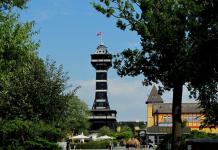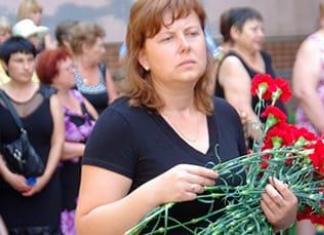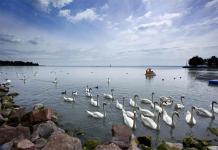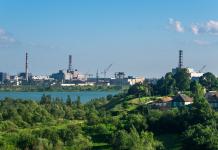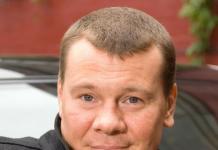It just so happened that I had already been to nuclear power plants, I know firsthand what it is and how it works in general terms, so before going to the Kursk NPP I did not experience typical philistine phobias at all about possible exposure to radiation. Endless thorough security checks, a rumbling machine room, a block control panel and everything else I have already gone through. But I have never had a chance to stand and take a picture practically on the "lid" of a boiling nuclear reactor!
02
. But I will start traditionally with a small historical introductory. The Kursk NPP, together with plants of equal capacity, makes up the four largest nuclear power plants in Russia. Located in the suburbs of the city of Kurchatov, 40 km from Kursk. For centuries, Kursk villages and villages existed on this land: Glushkovo, Starodubtsevo, Pykhtino, Tarasovo, Leonovo, Uspenskoye, Myasnyankino and Zatolokino. In 1965, due to the shortage of solid fuel in the European part of the USSR, an extensive program was adopted for the construction of nuclear power plants, including the Kursk NPP on the same site where the GRES was originally designed. The first builders arrived at the construction site of the nuclear power plant and the future city of nuclear scientists at the end of 1967, having justified the pioneer settlement in the area of the Lukashevka station. The construction of the power plant began in 1971 and was carried out in two stages. The first stage was completed in 1979 (commissioned: the first power unit in October 1976, the second - in January 1979), the second - in 1985 (the third power unit was commissioned in October 1983 and the fourth - December 1985). ). Started in 1985, the construction of the third stage (fifth and sixth (launched in 1986) was mothballed in 2012 and 1993, respectively, in blocks. 
03
. Kurchatov is the third largest city in the Kursk region and one of the most comfortable cities in the Kursk region (award for the most comfortable city in 2004, 2006 and 2011). 
04
. Kurchatov and the nuclear power plant are located on the banks of the Kurchatov reservoir, which some call the Kursk Sea, but it is more correct to call it a cooling pond. The area of the reservoir is more than 22 square kilometers. 
05
. A paradise place, I tell you, for lovers of fishing and mystical landscapes. 
06
. Since the water from the pond is used to cool the condensers of the turbines of the nuclear power plant, as well as other auxiliary equipment, and, accordingly, the water in it is much warmer than the environment, thick fogs are the most common thing here, and the fish are just teeming. 
07
. Let me explain a little about the fish. A number of requirements are imposed on the water that is taken for the technological needs of nuclear power plants. Roughly speaking, it should be as clean as possible in order to prevent clogging of the system. And warm water, of course, causes rapid growth of algae, which are also undesirable in the technological process. In this regard, a special hydraulic engineering workshop operates at the Kursk NPP, which breeds various species of fish that feed on algae and shells (black and white carp, silver carp, carp and even Japanese koi) for biological water treatment. And at the bottom of deep holes, as they say on fishing forums, there are catfish weighing up to 300 kg (!!!) 
08
. Shrimp of the genus Macrobrachium, which belongs to the long-clawed shrimps, are not surprised at the Kurchatov city beaches. They appeared in the reservoir in August 2007. Literally a bucket was brought in and released, and now they have populated the entire pond. The goal is still the use of crustaceans in the framework of biological reclamation for water purification. Freshwater shrimp build their shell by extracting hardness salts from the water. In addition, they feed on dead plants and organisms, which also cleanses the pond. 
09
. Naturally, where there are a lot of fish, there are a lot of poachers with nets and birds. 
10
. There are especially many birds on the watershed of the Kursk reservoir, which is a sandy spit overgrown with trees, shrubs and reeds. 
11
. There are more than 100 species of birds here. 
12
. What else to add? Unlike the Voronezh reservoir, in which no one bathes in their right mind and sober memory, beaches are equipped in Kurchatov, surfers ride and life is in full swing. 
13 . But let us return, in fact, to nuclear power plants. 
14
. At dawn, when the water soars, the shutters of the cameras also begin to smoke =) 
15
. The share of the Kursk NPP in the installed capacity of all power plants in the Chernozem region is more than 50%. It consists of four power units with a total capacity of 4 GW. 
16
. Unlike thermal power plants, whose pipes smoke soot, nuclear power plant pipes are used exclusively for ventilation. Through them, inert radioactive gases - xenon, krypton and argon - enter the atmosphere. But before being released into the atmosphere, the air from the premises of the nuclear power plant passes through a system of complex filters, where most of the radionuclides are removed. The short-lived isotopes decay before the gases reach the top of the tube, further reducing radioactivity. 
17
. Another photo from outside (hot water comes out here) and we go inside already. 
18
. Giant machine room 800 meters long. The fact is that it is common to all four power units. 
19
. Each unit is equipped with two K-500-65/3000-2 turbines with TVV-500-2 generators with a capacity of 500 MW each. 
20
. Three-phase generators, with water and hydrogen cooling. 
21
. It is no secret that most people are full of fears about nuclear energy, so there is a website russianatom.ru specially for them, where anyone can see the radiation situation at Rosatom enterprises. 
22
. Data are taken from dosimeters installed on the territory and in the vicinity of the nuclear power plant, controlled at a special radiation control point, where they are displayed on a large screen (pictured above) and then on the Internet. Thank you for the photo of me in the process of photographing the said screen vmulder
. Pay attention to the dress code for visiting the nuclear power plant. And we have individual dosimeters pinned to our chests. 
23
. We move on. NPP block control panel. I’ve already seen something like this, but I’m still shocked by how many buttons, sensors, levers and screens are here. It is clear that most of the parameters are monitored by automation, but still you are shy in front of such a power of scientific thought. 
24
. And finally, the promised reactor hall. It is there, under these cute "squares" of a giant mosaic, that nuclear reactions are seething !!! 
25
. Unlike the Novovoronezh NPP, where a different type of reactor and reactor hall is opened only once a year for maintenance, one can attend here for a short time, so to speak. And this circumstance, of course, is amazing! 
26
. Friends, forgive me generously, this time I did not go into detail about all the technical nuances of the operation of the nuclear power plant, since similar posts already exist on my blog, and besides, my colleagues with whom we side by side did this blog tour. See links to their reports below (the list will be updated). And I express my sincere gratitude to the organizers of the event, as well as to everyone who took part in it directly! 
Peer reports:
nordroden
Kursk nuclear power plant. Part 1.
Kursk nuclear power plant. Part two, technological.
Kursk nuclear power plant. Part 3
shtopor7
The Kursk NPP is located 40 km west of Kursk, on the banks of the Seim River.
The decision to build was made in the 60s in connection with the growing energy consumption of the region, after which, in 1976-1985, two stages of nuclear power plants (two power units each) were put into operation. Completion of the construction of the fifth power unit was proposed to be stopped, since its commissioning will lead to a drop in electricity prices in the region. This, according to the management of RosAtom, is undesirable.
1. First, we were taken to the museum, where there was such a sectional diagram of the reactor
4. The Kursk NPP works like this: in the reactor, when water boils (which flows in a closed circuit), steam is formed. It is fed to the turbines. Cooling pond water is used to cool the exhaust steam in the turbine condensers. The area of the mirror of the reservoir is 21 square km
5. Huge fish live in the pond. They do not allow water to overgrow - they eat algae. I once saw similar ones on the Patriarchal
6. Just in case, they hung a sign
7. View of the nuclear power plant. The pipes have the same purpose. They look different, as they serve different power units
8. And this is diesel. The deployment of diesel engines in the event of an accident will take about 15 seconds. At this time, water will be supplied from the reserve tanks to cool the reactor. The capacity of the tanks is enough for about a minute
9. Incomprehensible cylinders. Readers kindly suggested that these are diesel fuel separators, and in the foreground is a filter
10. And one more. Again, I will give the floor to the prompting reader: "judging by the color of the cylinders and the markings - cylinders with carbon dioxide of the fire extinguishing system"
11. By the way, at Fukushima, all the diesel engines were on the coast and were washed away by the first wave. On Kurskaya, they are located at different heights and are spaced throughout the station. That will keep the supply of electricity for the needs of the station under any conditions. The Japanese also managed to look for the necessary plugs for the restoration of power supply almost a day after the disaster.
In general, the experience of Chernobyl was absolutely not taken into account
12. We are moving from diesel to a radioactive waste storage facility under construction
13. Cocoon blocks are designed for storage and transportation of spent nuclear fuel from RBMK-1000 reactors. They are a reinforced concrete container with a wall thickness of about 25 cm
15. All places are carefully marked
17. And these are radiation pollution sensors. If the green light is on, everything is fine.
18. And if the red lights up, then the entire management of the station runs to the shelter. And he exercises command behind tightly closed hermetic doors. Arrival time at the shelter up to 15 minutes
19. There are personal protective kits at the entrance
20. And here is the hall itself, from where they will monitor the state of affairs at the emergency station. To the right and behind my back are very secret maps, on which all the security sensors at the station are marked. But they were not allowed to take them =(
In general, a lot of things are not allowed to be filmed due to the fact that a piece of a fence or a camera can get into the frame. This will undermine the security of the country. At the same time, the technologies used at the station are not secret.
21. Boxes of individual dosimeters. Everyone is given these with zero readings. At the exit, they look at what dose of radiation you have gained.
22. We move to the turbine hall. It's a paradise for graphics lovers, but time is naturally limited.
23. Its length is about 800 meters and it is common to all four NPP units
29. Each power unit of the Kursk NPP is equipped with two K-500-65 / 3000-2 turbines with generators with a capacity of 500 MW each
30. This inscription indicates the permissible maximum load on the surface
(800 Kg/S per 1 sq.m)
32. Local fire extinguishing system
33. CPU - central control panel. In this case, the control panel for the first power unit
34. How engineers understand all this, I have no idea. The pointer devices on the control panel on the right are synchro-receivers. They show the immersion depth of the control rods.
36. And here is the heart of the station - the reactor. It is located in a concrete shaft measuring 21 by 21 m and a depth of 25 m. This shaft houses an active zone - a laying of graphite "bricks".
Each such brick is a graphite bar with a base of 25x25 cm and a height of 20-60 cm. Each block has cylindrical holes into which fuel, control and protection systems and other necessary things are installed.
The blocks are assembled in 2488 columns, of which approximately 1.5 thousand are equipped with fuel channels.
All this graphite masonry with channels forms a cylinder 7 m high and 11 m in diameter, which is surrounded by upper and lower steel protective plates.
A light cylindrical casing is arranged on the sides. To prevent graphite oxidation and improve heat transfer, the reactor space is filled with a mixture of helium and nitrogen.
37. The unloading and loading machine is designed for reloading nuclear fuel at a running or stopped reactor
Rosatom State Corporation is implementing a large-scale NPP construction program both in the Russian Federation and abroad. Currently, Rosatom is building 3 new power units and a floating nuclear thermal power plant (FNPP) in Russia. The portfolio of foreign orders includes 36 blocks at different stages of implementation. Below is information about some of them.
NPPs under construction in Russia
Kursk NPP-2 is being built as a replacement plant to replace the decommissioned power units of the operating Kursk NPP. The commissioning of the first two power units of Kursk NPP-2 is planned to be synchronized with the decommissioning of power units No. 1 and No. 2 of the operating plant. The developer - the technical customer of the object - Rosenergoatom Concern JSC. General designer - JSC ASE EC, general contractor - ASE (Engineering Division of Rosatom State Corporation). In 2012, pre-engineering and environmental surveys were carried out to select the most preferred site for the four-unit station. Based on the results obtained, the Makarovka site, located in close proximity to the operating NPP, was selected. The ceremony of pouring the "first concrete" at the Kursk NPP-2 site took place in April 2018.
Leningrad NPP-2
Location: near Sosnovy Bor (Leningrad region)
Reactor type: VVER-1200
Number of power units: 1 - under construction, 2 - under the project

The station is being built on the site of the Leningrad NPP. The designer is JSC ATOMPROEKT, the general contractor is JSC CONCERN TITAN-2, the functions of the customer-builder are performed by JSC Concern Rosenergoatom. The project of the future nuclear power plant in February 2007 received a positive conclusion from the Glavgosexpertiza of the Russian Federation. In June 2008 and July 2009, Rostekhnadzor issued licenses for the construction of power units at Leningrad NPP-2, the lead nuclear power plant under the AES-2006 project. The LNPP-2 project with pressurized water reactors with a capacity of 1200 MW each meets all modern international safety requirements. It uses four active independent channels of security systems, duplicating each other, as well as a combination of passive security systems, the operation of which does not depend on the human factor. The safety systems of the project include a melt localization device, a system for passive heat removal from under the reactor shell and a system for passive heat removal from steam generators. The estimated service life of the station is 50 years, the main equipment is 60 years. The physical start-up of power unit No. 1 of the Leningrad NPP-2 took place in December 2017, and the power start-up took place in March 2018. The unit was put into commercial operation on November 27, 2018. Power unit No. 2 is under construction.
Floating nuclear power plant
Location: Pevek (Chukotka Autonomous Okrug)
Reactor type: KLT-40S
Number of power units: 1

The floating nuclear thermal power plant (FNPP) consists of a coastal infrastructure and a floating power unit (FPU) "Akademik Lomonosov", equipped with two shipboard nuclear reactors of the KLT-40S type. Similar reactor plants have extensive experience of successful operation on the Taimyr and Vaigach nuclear-powered icebreakers and the Sevmorput lighter carrier. The electrical power of the station is 70 MW.
The floating power unit is industrially constructed at the shipyard and delivered to the place of placement by sea in a completely finished form. Only auxiliary facilities are being built at the placement site, which ensure the installation of a floating power unit and the transfer of heat and electricity to the shore. According to the project, fuel reloading will be carried out once every seven years, for this the station will be towed to the manufacturing plant.
The construction of the first floating power unit began in 2007 at OAO PO Sevmash. In 2008, the project was handed over to Baltiysky Zavod OJSC in St. Petersburg. In June 2010, the floating power unit was launched. In July 2016, mooring trials began on the world's first floating power unit. In May 2018, the Akademik Lomonosov, which left the territory of the Baltic Shipyard in April 2018, successfully moored in Murmansk, at the site of FSUE Atomflot (a subsidiary of Rosatom), where nuclear fuel was loaded. In September 2019, the Akademik Lomonosov successfully moored ahead of schedule at its main base - in the city of Pevek, Chukotka Autonomous Okrug (ChAO). In December 2019, the FNPP supplied the first electricity to the isolated grid of the Chaun-Bilibino hub of the ChAO.
NPPs under construction abroad
Akkuyu NPP (Turkey)
Location: near Mersin (Mersin province)
Reactor type: VVER-1200
Number of power units: 4 (under construction)

The project of the first Turkish nuclear power plant includes four power units with the most modern Russian-designed VVER-1200 reactors with a total capacity of 4,800 megawatts.
This is a serial project of a nuclear power plant based on the Novovoronezh NPP-2 project (Russia, Voronezh region), the estimated service life of the Akkuyu NPP is 60 years. The design solutions of the Akkuyu NPP meet all the modern requirements of the world nuclear community, enshrined in the safety standards of the IAEA and the International Advisory Group on Nuclear Safety and the requirements of the EUR Club. Each power unit will be equipped with state-of-the-art active and passive safety systems designed to prevent design basis accidents and/or limit their consequences. An intergovernmental agreement between the Russian Federation and Turkey on cooperation in the construction and operation of a nuclear power plant at the Akkuyu site in Mersin province on the southern coast of Turkey was signed on May 12, 2010. The general customer and investor of the project is Akkuyu Nuclear JSC (AKKUYU NÜKLEER ANONİM ŞİRKETİ, a company specially established to manage the project), the general designer of the plant is Atomenergoproekt JSC, the general construction contractor is Atomstroyexport JSC (both are part of the engineering division of Rosatom ). The technical customer is Rosenergoatom Concern OJSC, the scientific supervisor of the project is the Federal State Institution NRC Kurchatov Institute, Rusatom Energy International JSC (REIN JSC) is the project developer and the majority shareholder of Akkuyu Nuclear. The main volume of supplies of equipment and high-tech products for the implementation of the project falls on Russian enterprises, the project also provides for the maximum participation of Turkish companies in construction and installation work, as well as companies from other countries. Subsequently, Turkish specialists will be involved in the operation of nuclear power plants at all stages of its life cycle. According to the intergovernmental agreement dated May 12, 2010, Turkish students study at Russian universities under the program for training nuclear energy specialists. In December 2014, the Turkish Ministry of Environment and Urban Development approved the Akkuyu NPP Environmental Impact Assessment (EIA) Report. The groundbreaking ceremony for the offshore structures of the nuclear power plant took place in April 2015. On June 25, 2015, the Turkish Energy Market Regulatory Authority issued Akkuyu Nuclear a preliminary license for electricity generation. On June 29, 2015, a contract was signed with the Turkish company "Cengiz Insaat" for the design and construction of offshore hydraulic structures of the nuclear power plant. In February 2017, the Turkish Atomic Energy Agency (TAEK) approved the design parameters for the Akkuyu NPP site. On October 20, 2017, Akkuyu Nuclear JSC received a limited construction permit from TAEK, which is an important milestone on the way to obtaining a license to build a nuclear power plant. On December 10, 2017, a solemn ceremony was held at the Akkuyu NPP site to start construction under the LPC. As part of the ORS, construction and installation work is carried out at all nuclear power plant facilities, with the exception of buildings and structures related to the safety of the "nuclear island". Akkuyu Nuclear JSC is closely cooperating with the Turkish side on licensing issues. On April 3, 2018, a solemn ceremony of pouring the "first concrete" took place. Concreting of the foundation slab of power unit No. 1 was completed. In December 2019, Akkuyu Nuclear JSC signed an agreement with TEIAS to connect the Akkuyu NPP to the Turkish energy system. It is to conduct full-scale work on the creation of a power distribution scheme for the Akkuyu NPP, which includes six high-voltage power lines.
Belarusian NPP (Belarus)
Location: Ostrovets city (Grodno region)
Reactor type: VVER-1200
Number of power units: 2 (under construction)

The Belarusian NPP is the first nuclear power plant in the history of the country, the largest project of Russian-Belarusian cooperation. The construction of the NPP is carried out in accordance with the Agreement between the governments of the Russian Federation and the Republic of Belarus, concluded in March 2011, under the full responsibility of the general contractor ("turnkey"). The station is located 18 km from the town of Ostrovets (Grodno region). It is being built according to a typical generation 3+ design that fully complies with all post-Fukushima requirements, international standards and IAEA recommendations. The project provides for the construction of a two-unit nuclear power plant with VVER-1200 reactors with a total capacity of 2400 MW. The general contractor for the construction is the Engineering Division of Rosatom State Corporation (ASE). At present, power unit No. 1 is at a high stage of readiness. Now it is actively conducting pre-commissioning and testing. There is a stage of hot running of the equipment of the reactor plant at nominal parameters. The next stage is the delivery of fresh nuclear fuel, followed by a physical launch. The inclusion of the generator in the network is scheduled for 2020. Construction work is being completed at power unit No. 2. The main equipment has been installed. The pace of thermal installation and electrical installation work is being increased to ensure the supply of voltage for their own needs, which will allow specialists to start full-scale commissioning this year.
NPP "Kudankulam" (India)
Location: near Kudankulam (Tamil Nadu)
Reactor type: VVER-1000
Number of power units: 4 (2 - in operation, 2 - under construction)

Kudankulam NPP is a nuclear power plant with VVER-1000 power units located in the south of India, in the state of Tamil Nadu. It is being built within the framework of the implementation of the Interstate Agreement concluded in November 1988, and its supplement dated June 21, 1998. The technical customer and developer is the Indian Atomic Energy Corporation (NPCIL). The integration of the Kudankulam NPP construction project is carried out by JSC Atomstroyexport (Engineering Division of the State Corporation Rosatom), the general designer is JSC Atomenergoproekt, the general designer is OKB Gidropress, and the supervisor is the RRC Kurchatov Institute. The AES-92 project, according to which the station is being built, was developed by the Atomenergoproekt Institute (Moscow) on the basis of serial power units that have been operated in Russia and Eastern Europe for a long time. The first power unit of the Kudankulam NPP was put into commercial operation in April 2017. The second power unit was connected to the grid in August 2016. In April 2014, the Russian Federation and India signed a general framework agreement on the construction with the participation of Russia of the second stage (power units No. 3 and No. 4) of a nuclear power plant, and in December of the same year, documents allowing it to begin construction. In June 2017, the Engineering Division of Rosatom State Corporation and the Indian Atomic Energy Corporation signed an agreement on the construction of the third stage (power units No. 5 and No. 6) of the Kudankulam NPP. In July 2017, contracts were signed between JSC Atomstroyexport and NPCIL for priority design work, detailed design and supply of main equipment for the third stage of the plant.
NPP "Paks-2" (Hungary)
Location: near Paks (Tolna region)
Reactor type: VVER-1200
Number of power units: 2

At the moment, the Paks NPP, built according to the Soviet design, has four power units with VVER-440 reactors. In 2009, the Hungarian parliament approved the construction of two new power units at nuclear power plants. In December 2014, Rosatom State Corporation and MVM (Hungary) signed a contract for the construction of new power plant units. In March of the same year, Russia and Hungary signed an agreement on a loan of up to 10 billion euros for the completion of the Paks NPP. It is planned that two units (No. 5 and No. 6) of the VVER-1200 project will be built at the Paks-2 NPP. General designer - JSC "ATOMPROEKT".
Rooppur NPP (Bangladesh)
Location: near the village. Rooppur (Pabna District)
Reactor type: VVER-1200
Number of power units: 2

An intergovernmental agreement on cooperation in the construction of the first Bangladesh nuclear power plant Rooppur was signed in November 2011. The first stone for the construction of the station was laid in autumn 2013. Currently, the preparatory stage of construction of power units No. 1 and No. 2 is being carried out. The general contractor is ASE (Engineering Division of Rosatom State Corporation), the project implementation site is a site 160 km from Dhaka. Construction is carried out at the expense of a loan provided by Russia. The project complies with all Russian and international safety requirements. Its main distinguishing feature is the optimal combination of active and passive safety systems. On December 25, 2015, the general contract for the construction of Rooppur NPP in Bangladesh was signed. The document defines the obligations and responsibilities of the parties, the timing and procedure for the implementation of all work and other conditions for the construction of the NPP. The first concrete was poured on November 30, 2017. Currently, construction and installation work is being carried out at the construction site of the station.
NPP "Shudaipu" (China)
Location: near Huludao (Liaoning Province, Northeast China)
Reactor type: VVER-1200
Number of power units: 2 - power units No. 3 and No. 4

On June 8, 2018, an intergovernmental protocol was signed on cooperation in the serial construction of Xudapu NPP power units in China and a framework contract for this. Based on these documents, the following contracts were signed: in March 2019, a contract for the technical design for units No. 3 and No. 4 of the station, and in June 2019, a general contract for units No. 3 and No. 4 of the Xudapu Nuclear Power Plant. On the Russian side, the contracts were signed by Atomstroyexport Joint-Stock Company, and with the Chinese side, by enterprises of the CNNC corporation (Suneng Nuclear Energy Company (CNSP), Liaoning Nuclear Energy Company (CNLNPC), China Nuclear Energy Industry Company (CNEIC). Designer of the "nuclear island" "JSC ATOMPROEKT acts, new power units are being built according to the AES-2006 project. In accordance with the contracts, the Russian side will design the nuclear island of the station, supply key equipment of the nuclear island for both units, and also provide services for designer supervision, installation supervision The intergovernmental protocol and the framework contract provide for the possibility of constructing subsequent power units of the Xudapu NPP This issue will be considered within the framework of state procedures established in the People's Republic of China.
Tianwan NPP (China)
Location: Near Lianyungang (Lianyungang County, Jiangsu Province)
Reactor type: VVER-1000 (4), VVER-1200 (2)
Number of power units: 6 (4 - in operation, 2 - under construction)

The Tianwan NPP is the largest object of Russian-Chinese economic cooperation. The first stage of the station (power units No. 1 and No. 2) was built by Russian specialists and has been in commercial operation since 2007. Annually, over 15 billion kWh of electricity is generated at the first stage of the nuclear power plant. Thanks to the new safety systems ("melt trap"), it is considered one of the most modern plants in the world. The construction of the first two units of the Tianwan NPP was carried out by a Russian company in accordance with the Russian-Chinese intergovernmental agreement signed in 1992.
In October 2009, Rosatom State Corporation and the China Nuclear Industry Corporation (CNNC) signed a protocol on continuing cooperation in the construction of the second stage of the station (power units No. 3 and No. 4). The general contract was signed in 2010 and entered into force in 2011. The construction of the second stage of the nuclear power plant is carried out by the Jiangsu Nuclear Power Corporation (JNPC). The second stage became a logical development of the first stage of the station. The parties applied a number of upgrades. The project has been improved from a technical and operational point of view. Responsibility for the design of a nuclear island was assigned to the Russian side, for the design of a non-nuclear island - to the Chinese side. Construction, installation and commissioning work was carried out by the Chinese side with the support of Russian specialists.
The pouring of the "first concrete" at power unit No. 3 took place on December 27, 2012, the construction of power unit No. 4 began on September 27, 2013. On December 30, 2017, the power start-up of power unit No. 3 of the Tianwan NPP took place. On October 27, 2018, the power start-up of unit No. 4 of the Tianwan NPP took place. At present, power unit No. 3 has been handed over to the Jiangsu Nuclear Power Corporation (JNPC) for a 24-month warranty operation, and power unit No. 4 has been transferred to commercial operation on December 22, 2018.
On June 8, 2018, a strategic package of documents was signed in Beijing (PRC) defining the main directions for the development of cooperation between Russia and China in the field of nuclear energy for the coming decades. In particular, two new power units with VVER-1200 reactors of the 3+ generation will be built: power units No. 7 and No. 8 of the Tianwan NPP.
NPP "Hanhikivi-1" (Finland)
Location: near the village of Pyhäjoki (Northern Ostrobothnia region)
Reactor type: VVER-1200
Number of power units: 1

In December 2013, representatives of ROSATOM companies signed a package of documents with Finnish partners on the implementation of the project for the construction of a single-unit nuclear power plant Hanhikivi-1 with a VVER-1200 reactor near the village of Pyhäjoki (Northern Ostrobothnia region). The Hanhikivi-1 NPP construction project is managed by JSC Rusatom Energy International (former name JSC Rusatom Overseas), its subsidiary RAOS Project Oy is the general contractor for the project. The General Designer of the Hanhikivi-1 NPP is JSC ATOMPROEKT (ASE (Engineering Division of the State Corporation Rosatom), OKB GIDROPRESS is developing the documentation for the technical design of the reactor plant. The main subcontractor for the construction of the Hanhikivi-1 NPP is JSC CONCERN TITAN-2", which is also building the Leningrad NPP-2 in Sosnovy Bor, which is a reference project for the Hanhikivi-1 NPP. The share of Rosatom State Corporation in the project is 34%. Preparatory work is currently underway at the site. Works have been carried out to deepen the bottom of the port basin Drilling and blasting and excavation for the construction of the excavation are underway Quality control of dust content, noise and vibration levels during excavation and stone crushing, as well as monitoring of water runoff from the settling pond and sea waters in the construction site sites.
The author writes: When I was offered to go to the Kursk NPP, I did not really think about it. If an enchanting failure happens, like on Balakovskaya, then I will have another black pictures, and I’ll write the text :). If it doesn't happen, then I'll just have good material. It turned out the second.
The Kursk Nuclear Power Plant is located 40 kilometers west of the city of Kursk, on the banks of the Seim River. Kurchatov is located 3 km from it. The decision to build the station was made in the mid-1960s. Start of construction - 1971. The need for energy capacities was caused by the rapidly developing industrial and economic complex of the Kursk Magnetic Anomaly.
The Kursk NPP is a single-circuit type plant: the steam supplied to the turbines is formed directly in the reactor when the coolant passing through it boils. As a heat carrier, ordinary purified water circulating in a closed circuit is used. Cooling pond water is used to cool the exhaust steam in the turbine condensers. The area of the mirror of the reservoir is 21.5 square meters. km.
1. Before visiting the station, our general background is measured (I'm not sure if the word background is correct here, but I don't know how else to say it). To do this, sit in a chair for a couple of minutes. Do the same at the end of the tour. Addition.

2. An alarm system with a complex of sensors is hung in all the premises of the station. In short, green means that everything is fine. Yellow - you have to tick. Red - in general, there is no need to rush anywhere. In fact, these are three levels of radiation, and each level has its own actions and rules.

3. The headquarters of the civil defense is located in the shelter number 1.

4. E... bow, excuse me, a self-portrait in the uniform that we were given. We undressed, again, sorry, down to our underpants, leaving the most important thing with us: a passport and a camera.

5. RBMK-1000 - Channel High Power Reactor. Who wants to read more about them, you can do it on Wikipedia or on the website of the Kursk NPP.

6. Unloading and loading machine designed for reloading fuel. The process can take place both on a stopped reactor and on a working one.

7. Before the accident at the Chernobyl nuclear power plant in the USSR, there were extensive plans to build RBMK reactors, but after the accident, plans to build these power units at new sites were curtailed. After 1986, two RBMK reactors were put into operation: RBMK-1000 at Smolensk NPP (1990) and RBMK-1500 at Ignalina NPP (1987) (the station is located in Lithuania and is now completely decommissioned). Another RBMK-1000 reactor of Unit 5 of the Kursk NPP is under construction. The existing reactors underwent a comprehensive reconstruction and modernization, which significantly increased their safety.

8. The central hall is designed to accommodate complexes of systems, transport and technological equipment and facilities for the assembly and storage of fresh fuel, for refueling and storage of spent fuel, for the repair and replacement of reactor equipment. Equipment and technological systems are placed in the central hall: Reactor Plateau closed by assemblies; Spent fuel pools (SP) for spent fuel and spent technological channels; Unloading and loading machine (RZM); Balcony with fresh fuel hanging stand; CZ crane and cantilevered mobile crane; Training stand; Unit for decontamination of suspensions of fuel assemblies (FA), etc.

9. Each central hall has two spent nuclear fuel pools. Each spent fuel pool is filled with water to cool SFAs and provide biological protection to personnel. This is a traditional shot of a fuel rod glowing underwater.

10. We all take pictures of the hole that Enigma almost fell into. He stepped on another metal thing that covers the pool. And the lid did a somersault and flew off into the black-blue depths. Enigma remained upstairs, slightly surprised. After that, we quickly left the roof of the soaking pool.

11. One of the many control rooms.

12. Dosimeters.

13. Dispatching switchgear.

14. I quote: “Each power unit of the Kursk NPP is equipped with two K-500-65 / 3000-2 turbines with generators with a capacity of 500 MW each. The turbines are single-shaft, dual-flow: one high-pressure cylinder (HPC) and four low-pressure cylinders (LPC). A separator-superheater (SHR) is installed between the HPC and the LPC. Three-phase generators, with water and hydrogen cooling. Turbine generators are block connected to an open electrical substation. Energy for the NPP's own needs comes from the auxiliary transformer.

15. A huge engine room, common to all four power units.

16.

17. Mushroom glade - electric motors for automatic drive of all kinds of valves.

18. It was possible to shoot only in the halls or in the rooms. During the passage through the corridors, we were asked to cover the lenses with caps. If someone did not have it or had a soap dish, then the security officer took the camera and gave it to the next room, where you can shoot.

19. Block control panel.

20.
21. Our escort - Zubov Vasily Ivanovich. He can talk for hours about the station. Just keep asking.

22. By the way, the Chernobyl nuclear power plant was built according to the plans of the Kursk one. And in the photo - one of the corridors, where there are lockers with individual dosimeters.

23. Exit. All clean - the green signal is on.

24. Spray pool against the background of power units. The pool serves to cool the water that circulates in the diesel engine cooling system. So that the pool does not overgrow, fish are bred in it: catfish, grass carp and Japanese carp.

25. Power unit No. 5 of the Kursk NPP is a third-generation unit with the most advanced nuclear-physical characteristics, equipped with reliable control and protection systems. Its construction began on December 1, 1985, after the 90s it continued intermittently and was finally stopped in the mid-2000s, despite the fact that the power unit already had a high degree of readiness - the equipment of the reactor shop was installed by 70%, the main equipment of the RBMK reactor - by 95%, turbine shop - by 90%. In March 2011, it became known that the commissioning of the 5th power unit of the Kursk NPP could require 3.5 years and 45 billion rubles without VAT in 2009 prices, and that the final decision to continue construction would be made in 2012. The option of using the new VVER-1200 reactor at the 5th power unit is also being considered, which, in fact, will require a complete change in the design.

26. One of the diesel engines for emergency power supply.

27.

28. Cocoon block TUK-109, designed for storage and transportation of spent nuclear fuel from RBMK-1000 reactors.

29. A special device ("nozzle") of an overhead crane for operations with a container.

30. Training block control panel.

31.

32. A complete analogue of one of the control rooms at the station itself.

33. The instructors played out the Fukushima scenario (total power loss) and dealt with a drill.


